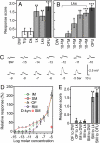L-Kynurenine, an amino acid identified as a sex pheromone in the urine of ovulated female masu salmon
- PMID: 17030810
- PMCID: PMC1622830
- DOI: 10.1073/pnas.0604340103
L-Kynurenine, an amino acid identified as a sex pheromone in the urine of ovulated female masu salmon
Erratum in
- Proc Natl Acad Sci U S A. 2007 Jul 10;104(28):11862
Abstract
Many animals employ sex pheromones to find mating partners during their reproductive seasons. However, most sex pheromones of vertebrates remain to be identified. Over the past 20 years, steroids and prostaglandins have been identified as sex pheromones in several fishes. These pheromones are broadly termed "hormonal pheromones" because they or their precursors act as hormones in these fishes. Hitherto, no other type of sex pheromone has been unambiguously identified in teleost fish. Here we report the identification of a "nonhormonal pheromone" in teleost fish. The urine of the reproductively mature female masu salmon (Oncorhynchus masou) contains a male-attracting pheromone. Bioassay-guided fractionation yielded an active compound that was identical to L-kynurenine in spectral and chromatographic properties. L-Kynurenine is a major metabolite of L-tryptophan in vertebrates. This pheromone elicits a male-specific behavior at even picomolar concentrations; its electrophysiological threshold is 10(-14) M. L-Kynurenine is a reasonable substance for female masu salmon to advertise their readiness for mating.
Conflict of interest statement
The authors declare no conflict of interest.
Figures





Similar articles
-
F prostaglandins function as potent olfactory stimulants that comprise the postovulatory female sex pheromone in goldfish.Biol Reprod. 1988 Dec;39(5):1039-50. doi: 10.1095/biolreprod39.5.1039. Biol Reprod. 1988. PMID: 3219377
-
Sympatric, simultaneous, and random mating between markless trout (iwame; Oncorhynchus iwame) and red-spotted masu salmon (amago; Oncorhynchus masou ishikawae).Zoolog Sci. 2006 Jan;23(1):71-7. doi: 10.2108/zsj.23.71. Zoolog Sci. 2006. PMID: 16547408
-
Bile Acid secreted by male sea lamprey that acts as a sex pheromone.Science. 2002 Apr 5;296(5565):138-41. doi: 10.1126/science.1067797. Science. 2002. PMID: 11935026
-
The evolution of hormonal sex pheromones in teleost fish: poor correlation between the pattern of steroid release by goldfish and olfactory sensitivity suggests that these cues evolved as a result of chemical spying rather than signal specialization.Acta Physiol Scand. 1994 Oct;152(2):191-205. doi: 10.1111/j.1748-1716.1994.tb09799.x. Acta Physiol Scand. 1994. PMID: 7839863 Review.
-
Hormonally derived sex pheromones in fish: exogenous cues and signals from gonad to brain.Can J Physiol Pharmacol. 2003 Apr;81(4):329-41. doi: 10.1139/y03-024. Can J Physiol Pharmacol. 2003. PMID: 12769225 Review.
Cited by
-
Identification of olfactory receptor genes in the Japanese grenadier anchovy Coilia nasus.Genes Genomics. 2017;39(5):521-532. doi: 10.1007/s13258-017-0517-8. Epub 2017 Feb 23. Genes Genomics. 2017. PMID: 28458780 Free PMC article.
-
Importance of Probiotics in Fish Aquaculture: Towards the Identification and Design of Novel Probiotics.Microorganisms. 2024 Mar 21;12(3):626. doi: 10.3390/microorganisms12030626. Microorganisms. 2024. PMID: 38543677 Free PMC article. Review.
-
Male urine signals social rank in the Mozambique tilapia (Oreochromis mossambicus).BMC Biol. 2007 Dec 12;5:54. doi: 10.1186/1741-7007-5-54. BMC Biol. 2007. PMID: 18076759 Free PMC article.
-
Understanding behavioral responses of fish to pheromones in natural freshwater environments.J Comp Physiol A Neuroethol Sens Neural Behav Physiol. 2010 Oct;196(10):701-11. doi: 10.1007/s00359-010-0523-7. Epub 2010 Mar 30. J Comp Physiol A Neuroethol Sens Neural Behav Physiol. 2010. PMID: 20352435 Review.
-
Male lake char release taurocholic acid as part of a mating pheromone.J Exp Biol. 2024 Jan 15;227(2):jeb246801. doi: 10.1242/jeb.246801. Epub 2024 Jan 25. J Exp Biol. 2024. PMID: 38270203 Free PMC article.
References
-
- Wyatt TD. Pheromones and Animal Behaviour: Communication by Smell and Taste. Cambridge, UK: Cambridge Univ Press; 2003. p. 408.
-
- Colombo L, Marconato A, Belvedere PC, Friso C. Boll Zool. 1980;47:355–364.
-
- Van Den Hurk R, Lambert JGD. Can J Zool. 1983;61:2381–2387.
-
- Dulka JG, Stacey NE, Sorensen PW, Van Den Kraak GJ. Nature. 1987;325:251–253.
-
- Sorensen PW, Hara TJ, Stacey NE, Goetz FW. Biol Reprod. 1988;39:1039–1050. - PubMed
Publication types
MeSH terms
Substances
LinkOut - more resources
Full Text Sources
Other Literature Sources
Miscellaneous

